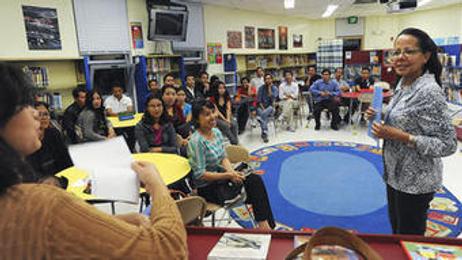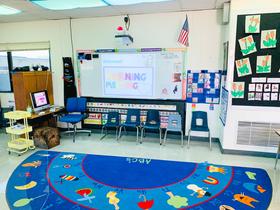With classrooms becoming more diverse, public schools are experimenting with new language programs to enhance ESL student learning.
ESL students, standing for English as a Second Language, typically need additional resources and support to adjust to the various linguistic complications of learning a new language. As a result, ESL students typically require additional funding.
However, as public schools are coping with reduced funding due to the economic recession, educational experts debate the best approach to balancing school budgets while caring for each child’s language development. To save costs, some schools and states have created mandatory full inclusion programs, where ESL students are immersed in a regular-paced English class with fluent English speakers. This strategy will reduce the costs of ESL specialists while still engaging ESL students in an atmosphere for learning.
While this approach helps balance school budgets, many educators and parents argue that the full-inclusion classroom is ineffective for both fluent and ESL children.
Public Schools and ESL Programs
As The Multicultural Education Journal explains, the 2001 national mandate, No Child Left Behind, required all public schools to help ESL students become proficient in English, as both fluent and ESL students are mandated to meet state and national achievement standards. While public schools are legally required to provide educational support for ESL kids, many experts assert that the current approach is ineffective and flawed. As the number of minority students is rising each year in the United States, experts predict that by the year 2020, at least 50 percent of school-age children will be of non-English speaking backgrounds. With the rising statistics of non-English speaking students in public schools, leaders assert that all schools must take a more active approach to protecting the instructional support for these non-English speaking students.
Furthermore, as Inside Higher Education supports,
“‘During turbulent economic times, educational programs that serve culturally, linguistically, and economically diverse student populations may be at a disadvantage when competing for reduced funding with programs that serve conventional, mainstream student populations.’”
Many educators fear that ESL students will be left behind because many schools are forced to lay off teachers, enlarge class sizes, and distribute more responsibilities among the current school staff.
For example, California is one of the many states that have implemented the “full inclusion” classroom approach, requiring all public schools to instruct classes solely in English. This approach, titled Proposition 227, provides ESL kids $50 million each year for additional English tutoring support; however, these students are forced to engage in fluent English classes, even if they have never been exposed to the language. This proposition, like many full inclusion programs, is not solely designed to save school budgets; moreover, all of the propositions for full inclusion have the backing of experts who assert that the best way to attain language fluency is through inclusion instructional methods. While full inclusion has research and studies to support its incentives, many leaders still argue that there are better ways to teach ESL and English-speaking students through non-inclusion practices.
Is Inclusion the Best Approach?
One of the biggest arguments against full English inclusion classrooms is revealed through the studies that assert ESL students adopt fluency more rapidly when engaging in specialized language support programs.
In addition to the argument that specialized support helps to increase ESL student learning, many educators and parents argue that the additional ESL support helps to maintain the challenging environment of a fluent classroom. Specifically, as a regular-paced English class is designed to instruct students of an “average” English-speaking proficiency, immersing non-English speaking students in such courses often forces teachers to slow the pace of instruction, making the overall class challenge rigorous for English-speaking students.
For example, when a teacher in a regular-paced history class assigns a research essay on a specific topic, that teacher must strive to accommodate his or her instruction and support to all students with needs—including language, learning, and cognition needs of both ESL and fluent students. Subsequently, as students work through their research papers, a single teacher’s ability to support each child becomes more challenging. The more children and special needs in each class, the less specialized support a single teacher can offer each student.
While various experts fear that inclusion programs diminish the educational opportunities for fluent and ESL students, many leaders and parents disagree. According to Education Week, while support programs are essential for ESL children and families, many believe that separate setting instructional methods, which involve separating ESL children from fully fluent classrooms for the entire or partial class period, inappropriately create an environment of segregation.
As Education Week reveals, many new ESL programs are currently being evaluated by protestors who assert that the separate setting methods violate federal civil rights laws. As public schools must provide equal educational opportunities for all students, some believe these programs only stimulate increased cultural bias as they do not provide opportunities for students of various and diverse backgrounds to interact. Some protest, “Special education and E.S.L. programs have undoubtedly made substantial progress... But it is time to move beyond unequal separate systems to integrated ones where all students can access all the necessary services for their success.”
New Trends and Considerations
In recent years, the debate over the best methods for ESL education has evolved with new trends and technological advancements. For instance, integrating virtual reality (VR) and augmented reality (AR) in ESL classrooms is gaining traction. These technologies provide immersive experiences that can help ESL students better understand and use English in real-world contexts. VR and AR can simulate environments where students can practice language skills interactively, which can be particularly beneficial for those who may not have access to native English-speaking environments.
Moreover, the emphasis on cultural awareness in ESL learning has become more pronounced. Culturally aware teaching methodologies can significantly boost learner engagement by reflecting students' cultures and languages in the learning material. This recognition increases their motivation and interest, fostering a more inclusive and effective learning environment.
Conclusion
Overall, while the debate continues, schools will be forced to make serious budgetary and educationally driven decisions regarding how to protect the needs of all students to ensure that neither ESL nor fluent students are left behind. The inclusion vs. exclusion debate in ESL education is complex and multifaceted, with valid arguments. As educational trends continue to evolve, policymakers, educators, and communities must collaborate in finding the most effective strategies to support the diverse needs of ESL students.
Overall, while the debate continues, schools will be forced to ask serious budgetary and educationally driven questions regarding how to protect the needs of all students to ensure that neither ESL nor fluent students are left behind.
Questions? Contact us on Facebook @publiccollegereview.












